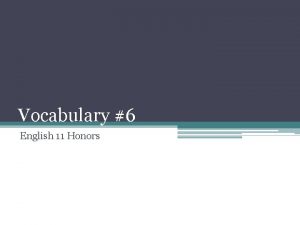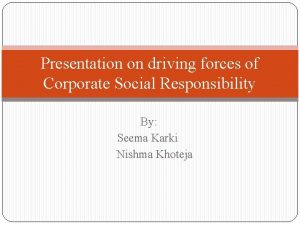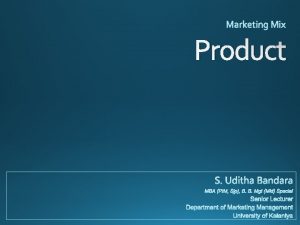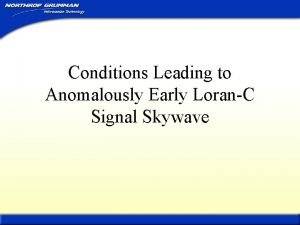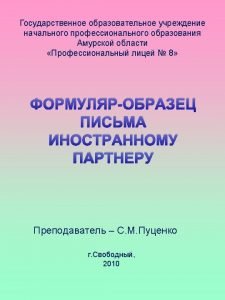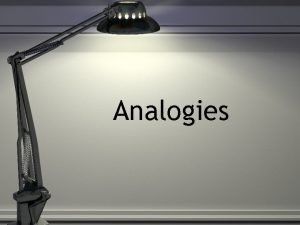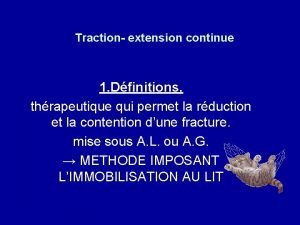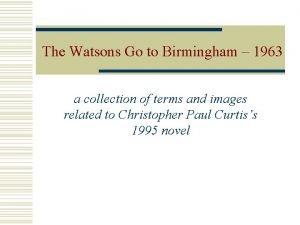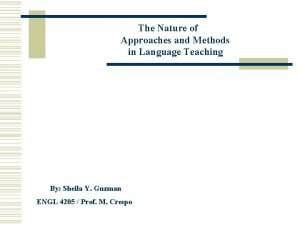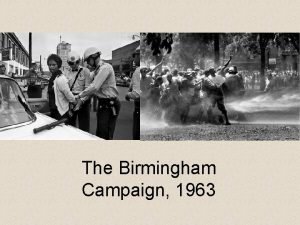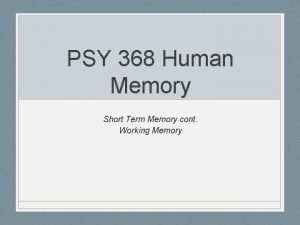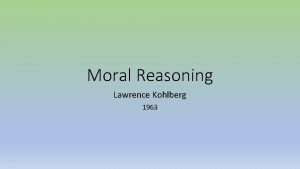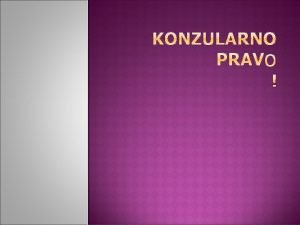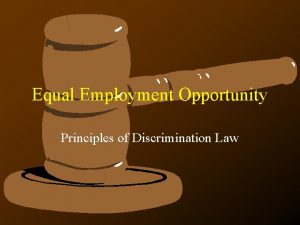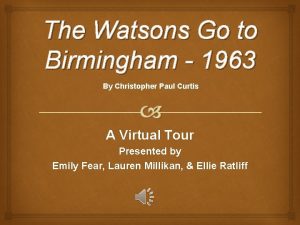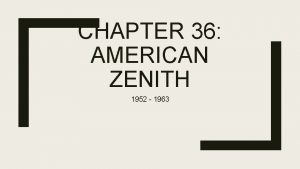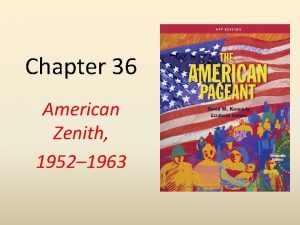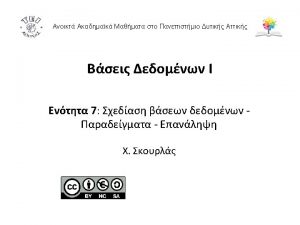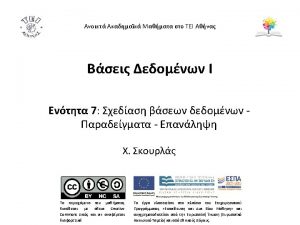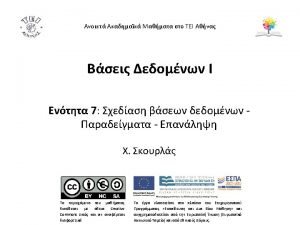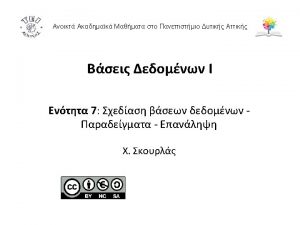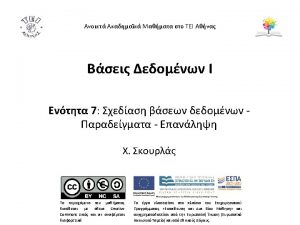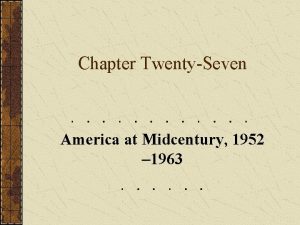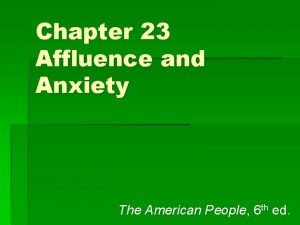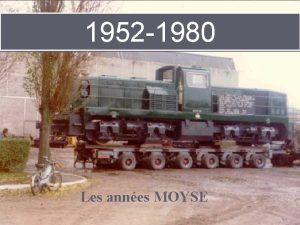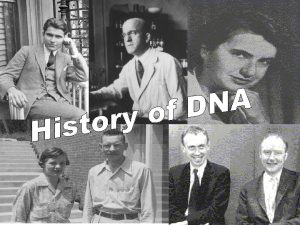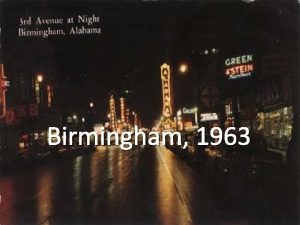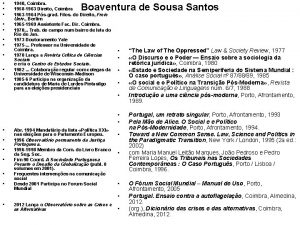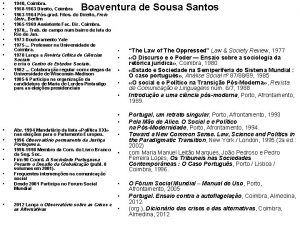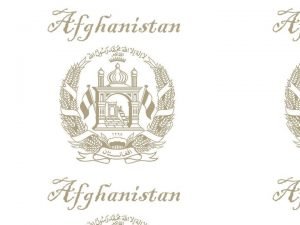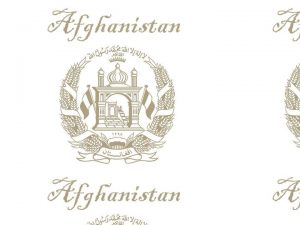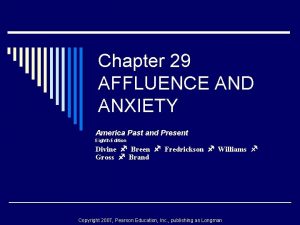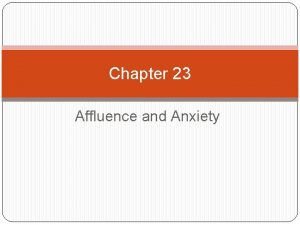Chapter 36 American Zenith 1952 1963 Affluence and























- Slides: 23

Chapter 36 American Zenith 1952 -1963

Affluence and Its Anxieties New Inventions and industries: transistor in sparked a revolution in electronics, especially in computers Aerospace industries grew in the 1950 s - due to Eisenhower's SAC and to an expanding passenger airline business 1956 - number of "white-collar" (no manual labor) workers exceeded the number of "blue-collar" (manual labor) workers International Business Machines (IBM) grew tremendously. union memberships declined. White-collar jobs opened up opportunities for women clerical and service jobs new dual role as a worker and a homemaker raised questions about family life and about traditional definitions of gender roles Feminist Betty Friedan published in 1963 The Feminine Mystique launched modern women's movement discussed widespread unhappiness of women who were housewives

Consumer Culture in the Fifties New innovations highlighted the emerging lifestyle of leisure and affluence credit card, fast-food, and new forms of recreation 1946 - only 6 TV stations, but 146 by 1956 "Televangelists" - Baptist Billy Graham - used the TV to spread Christianity. As population moved west, so did sports teams Popular music transformed during the 1950 s Elvis Presley created a new style known as rock and roll. Traditionalists were critical of Presley and many of the social movements during the 1950 s.

The Advent of Eisenhower Lacking public support for Truman - Democrats nominated Adlai Stevenson for the election of 1952 Republicans nominated Dwight D. Eisenhower already well-liked by the public. Richard M. Nixon chosen for vice-president to satisfy the anticommunist wing of the Republican Party. During this election, TV became a popular medium for campaigning. During the campaign, Nixon went on TV to defend himself against corruption allegations "Checkers speech". Eisenhower won the election of 1952 by a large majority. President Eisenhower attempted to end the Korean War July 1953, after Eisenhower threatened to use nuclear weapons, an armistice was signed, ending the Korean War. Despite the war, Korea remained divided at the 38 th Parallel. Eisenhower's leadership style of sincerity, fairness, and optimism helped to comfort the nation after the war.

Desegregating the South black life in the South were governed by Jim Crow laws Blacks segregated from whites economically inferior politically powerless. Gunnar Myrdal exposed the contradiction between America's professed belief that all men are created equal and its terrible treatment of black citizens in his book, An American Dilemma (1944). Sweatt v. Painter (1950), the Supreme Court ruled that separate professional schools for blacks failed to meet the test of equality Dec 1955 - Rosa Parks refused to give up her seat on a bus in Montgomery, Alabama Her arrest sparked a yearlong black boycott of the city buses (Montgomery bus boycott) and served notice throughout the South that blacks would no longer submit to segregation. Reverend Martin Luther King, Jr. rose to prominence during the bus boycott.

Seeds of the Civil Rights Revolution Hearing of the lynching of black war veterans in 1946, President Harry Truman ended segregation in federal civil service and ordered "equality of treatment and opportunity" in the armed forces in 1948. After Congress and new Pres Eisenhower ignored racial issues, Supreme Court Chief Justice Earl Warren stepped up to address civil rights for African Americans. Brown v. Board of Education of Topeka, Kansas (1954) Supreme Court ruled that segregation in public schools was unequal and, thus, unconstitutional reversed the previous ruling in Plessy v. Ferguson (1896). Southern states opposed the ruling Congressmen from these states signed the "Declaration of Constitutional Principles" in 1956, pledging their unyielding resistance to desegregation President Eisenhower did not support integration because he shied away from social issues Sept 1957, Orval Faubus, the governor of Arkansas, used the National Guard to prevent 9 black students from enrolling in Little Rock's Central High School Confronted with a direct challenge to federal authority, Eisenhower sent troops to escort the children to their classes.

Early Civil Rights Movement 1957 - Congress passed first Civil Rights Act since Reconstruction Days set up a permanent Civil Rights Commission to investigate violations of civil rights authorized federal injunctions to protect voting rights Reverend Dr. Martin Luther King, Jr. formed the Southern Christian Leadership Conference (SCLC) in 1957 February 1, 1960 - 4 black college students in Greensboro, North Carolina demanded service at a whites-only lunch counter sought to mobilize the power of black churches on behalf of black rights Within a week, the sit-in reached 1, 000 students, spreading a wave of wadeins, lie-ins, and pray-ins across the South demanding equal rights April 1960, southern black students formed the Student Non-Violent Coordinating Committee (SNCC) to give more focus to their efforts.

Eisenhower Republicanism at Home Eisenhower – somewhat socially liberal but economically and politically conservative Strived to balance federal budget and to guard America from socialism 1954, President Eisenhower deported a million illegal immigrants in Operation Wetback giving in to Mexican government's worries that illegal immigration to the US would undercut bracero program Eisenhower tried to revert to the policy of assimilating Native American tribes into American culture, but his plan was dropped in 1961 after most tribes refused to comply Eisenhower wanted to cancel New Deal programs, but lacked public support Supported the Federal Highway Act of 1956 created thousands of miles of federally-funded highways only managed to balance the budget 3 times while in office (8 years) 1959, he incurred the biggest peacetime deficit in the history of the United States

A "New Look" in Foreign Policy 1954, secretary of state John Foster Dulles proposed a policy of boldness in which a fleet of super-bombers would be built and equipped with nuclear bombs called the Strategic Air Command, or SAC would allow U. S. to threaten countries such as the USSR & China with nuclear weapons At the Geneva summit conference in 1955, President Eisenhower attempted to make peace with the new Soviet Union dictator, Nikita Khrushchev, following Stalin's death Peace negotiations were rejected

The Vietnam Nightmare Early 1950 s - nationalist movements tried to throw the French out of Vietnam leader Ho Chi Minh became increasingly communist while America became increasingly anticommunist After nationalists won at the Battle of Dien Bien Phu in 1954, a peace was called. Vietnam was divided at the 17 th parallel. Ho Chi Minh was given the north pro-Western government, led by Ngo Dinh Diem, was given the south Vietnamese nationalists were promised a nationwide election two years after the peace accords never happened because it looked the communists would win.

Cold War Crises in Europe 1955, West Germany was let into NATO Eastern European countries and the Soviets signed the Warsaw Pact communist military union to counteract NATO May 1955 - Soviets ended the occupation of Austria 1956 - Hungary rose up against Soviets attempting to win their independence When their request for aid from the United States was denied, they were slaughtered by the Soviet forces America's nuclear weapon was too big of a weapon to use on such a relatively small crisis

Cold War Crisis in the Middle East 1953 - effort to secure Iranian oil for Western countries CIA created a coup that installed Mohammed Reza Pahlevi as the dictator of Iran. President Nasser of Egypt sought funds from the West and the Soviets to build a dam on the Nile River After Americans learned of Egypt's involvement with the Soviets withdrew monetary offer Nasser nationalized the Suez Canal, owned by the French and British October of 1956, the French and British attacked Egypt, starting the Suez Crisis. two countries were forced to retreat after America refused to provide them with oil Eisenhower Doctrine: a 1957 pledge of U. S. military and economic aid to Middle Eastern nations threatened by communist aggression 1960, Saudi Arabia, Kuwait, Iraq, Iran, and Venezuela joined together to form the Organization of Petroleum Exporting Countries (OPEC)

Round Two for Ike President Eisenhower beat Democratic opponent, Adlai Stevenson, and was reelected in 1956 Fraud and corruption in American labor unions caused president to take an interest in passing labor laws 1959 - passed the Landrum-Griffin Act designed to hold labor leaders more accountable for financial illegalities Oct 4, 1957 - Soviets launched Sputnik I satellite into space Nov - launched Sputnik II - carrying a dog satellites gave credibility to Soviet claims that superior industrial production is achieved through communism In response, President Eisenhower established the National Aeronautics and Space Administration (NASA). technological advances in USSR made Americans think that the educational system of the USSR was better than the US system 1958, the National Defense and Education Act (NDEA) gave $887 million in loans to college students and in grants to improve teaching sciences and languages

The Continuing Cold War Due to environmental concerns – US & USSR suspended nuclear tests in March and Oct 1958, respectively July 1958 - Lebanon called for aid under the Eisenhower Doctrine as communism threatened to take over the country 1959 - Soviet dictator Khrushchev appeared before the U. N. General Assembly and called for complete disarmament 1960 - an American U-2 spy plane was shot down in Russia, ending the possibility of an quick peaceful resolution

Cuba's Castroism Spells Communism Latin Americans began to show dissent towards America as the US seemed to neglect Latin America's economic needs in favor of Europe's Also despised constant American intervention 1954 - CIA led a coup that overthrew leftist gov’t in Guatemala Fidel Castro led a coup that overthrew the Americansupported government of Cuba in 1959 Castro became militarily and economically allied with the Soviet Union military satellite for USSR August 1960 - Congress authorized $500 million to prevent communism from spreading in Latin America

Kennedy Challenges Nixon for the Presidency Republicans nominated Richard Nixon to run for president and Henry Cabot Lodge, Jr. for vice president in the election of 1960 Democrats nominated John F. Kennedy (JFK) to run for president and Lyndon B. Johnson (LBJ) for vice president JFK Catholicism irritated Protestant people in Bible Belt South JFK said Soviets, with their nuclear bombs and Sputniks, had gained on America's prestige and power Nixon forced to defend the existing administration (Republican) and claim that America's prestige had not slipped Television played a key role in presidential election as Kennedy's personal appeal attracted many people. Kennedy won the election of 1961, gaining support from workers, Catholics, and African Americans America was economically prosperous during the Eisenhower years. Alaska and Hawaii became states in 1959 As a Republican president, Eisenhower had helped integrate the reforms of the Democratic New Deal and Fair Deal programs into American life.

A Cultural Renaissance New York became art capital of the world after WWII Jackson Pollock helped develop abstract expressionism in the 1940 s and 1950 s American architecture also progressed after WWII Many skyscrapers were created in a modernist or "International Style. " Many new American authors Pre-war realist, Ernest Hemingway wrote The Old Man and the Sea (1952) John Steinbeck, another pre-war writer, wrote graphic portrayals of American society Joseph Heller's Catch-22 (1961) discussed the antics and anguish of American airmen in the wartime Mediterranean Problems created by new mobility and affluence of American life were explored by John Updike and John Cheever Louis Auchincloss wrote about upper-class New Yorkers Gore Vidal wrote a series of historical novels Poetry and playwrights also flourished during the postwar era New Cultural Voices Books by black authors made best-seller lists Led by William Faulkner, the South also had a literary renaissance

Kennedy's "New Frontier" Spirit JFK- youngest president to take office Assembled one of the youngest cabinets - included brother Robert Kennedy, the Attorney General - planned to reform the priorities of the FBI JFK pushed his "New Frontier" plans – included: Trying to fix unemployment and inflation and keeping wages high for workers This plan inspired patriotism Proposed the Peace Corps, an army of idealistic and mostly youthful volunteers to bring American skills to underdeveloped countries Southern Democrats and Republicans despised president's New Frontier plan JFK campaigned on theme of revitalizing the economy after the recessions of the Eisenhower years Tried to curb inflation 1962 - negotiated noninflationary wage agreement with the steel industry When the steel industry announced significant price increases, promoting inflation, President Kennedy lambasted the steel industry's executives. This caused the industry to lower its prices. Kennedy stimulated the economy by cutting taxes and putting more money directly into private hands (instead of spending more government money) Also proposed a multibillion-dollar plan to land an American on the moon (Apollo Program)

Foreign Flare-ups and "Flexible Response" August 1961 - Soviets began to construct the Berlin Wall - designed to stop the large population drain from East Germany to West Germany through Berlin Western Europe prospering after Marshall Plan aid and the growth of the European Economic Community (EEC) (also known as Common Market) EEC was the free-trade area that evolved into the European Union. Kennedy secured passage of the Trade Expansion Act in 1962, authorizing tariff cuts of up to 50% to promote trade between America and the Common Market countries Defense Secretary Robert Mc. Namara pushed the strategy of "flexible response“ Idea that America would deploy military options around the world that could match the necessities of the crisis at hand President Kennedy increased spending on the Special Forces Doctrine of "flexible response" lowered the level at which diplomacy would give way to troops Provided a way for a progressively and increasing use of force (ex: Vietnam).

Cuban Confrontations 1961 – JFK signed Alliance for Progress - essentially the Marshall Plan for Latin America Primary goal was to help Latin American countries close the gap between the rich and the poor, thus quieting communist politicians Results were disappointing as America's money did not impact Latin America's social problems. April 17, 1961 -1, 200 American-supported Cuban exiles landed at Cuba's Bay of Pigs An attempt by America to overthrow the Castro regime. JFK was against direct intervention of the overthrow of Castro, so he did not provide sufficient support for the exiles Invasion failed after the exiles were forced to surrender

Cuban Missile Crisis Continued American attempt to overthrow Castro caused Castro to further support the Soviets October 1962 - discovered Soviets were secretly installing nuclear missiles in Cuba JFK ordered naval "quarantine" of Cuba and demanded immediate removal of the weapons For a week, Americans waited while Soviet ships approached the patrol line established by the U. S. Navy off the island of Cuba Oct 28, Khrushchev agreed to a compromise in which he would pull the missiles out of Cuba, if US also agreed to end quarantine, not invade Cuba, and remove missiles from Turkey Late 1963 - pact made prohibiting trial nuclear explosions in the atmosphere was signed. June 1963 – JFK gave speech in which he encouraged Americans to abandon negative views of USSR Tried to lay the foundations for a realistic policy of peaceful coexistence

The Struggle for Civil Rights During JFK campaign – gained black vote Promised to pass civil rights legislation Slow to pass legislation during his presidency - didn't want to lose support from southern Congressmen 1960 - Freedom Riders in South tried to end segregation in facilities serving interstate bus passengers Southern officials did nothing to stop violence that had erupted at these protests Federal marshals were dispatched to protect the freedom riders. Kennedy and the King family (MLK) had a good relationship Voter Education Project - register the South's blacks Spring 1963, MLK launched campaign against discrimination in Birmingham, Alabama (most segregated big city in US Civil rights marchers repelled by police with attack dogs and high-pressure water hoses June 11, 1963 – JFK delivered speech to the nation - dedicated himself to finding a solution to the racial problems August 1963, Martin Luther King, Jr. led 200, 000 black and white demonstrators on a peaceful "March on Washington" in support of the proposed new civil rights legislation

The Killing of Kennedy November 22, 1963, President Kennedy was shot and killed as he was riding in an open limousine in Dallas, Texas alleged gunman was Lee Harvey Oswald was shot and killed by self-appointed avenger, Jack Ruby Vice President Lyndon B. Johnson sworn into office, retaining most of Kennedy's cabinet Kennedy was praised more for his ideals than what he had actually achieved
 Antipathy adjective
Antipathy adjective Driving forces behind csr
Driving forces behind csr Product augmentation
Product augmentation Skywave.zenith
Skywave.zenith Zurimba
Zurimba Tureen synonym
Tureen synonym Traction extension
Traction extension Zte ats
Zte ats Gingival index loe and silness 1963
Gingival index loe and silness 1963 Gullahorn and gullahorn (1963) w curve
Gullahorn and gullahorn (1963) w curve Edward anthony 1963
Edward anthony 1963 1963 brown bomber
1963 brown bomber Edward anthony 1963
Edward anthony 1963 1963 birmingham campaign
1963 birmingham campaign Cassie thinking about cubism
Cassie thinking about cubism Visual sketchpad memory
Visual sketchpad memory R v gill 1963
R v gill 1963 Kohlberg 1963
Kohlberg 1963 Anthony's model of language teaching
Anthony's model of language teaching Becka konvencija o konzularnim odnosima 1963
Becka konvencija o konzularnim odnosima 1963 Equal pay act 1963 summary
Equal pay act 1963 summary What is obedience in psychology
What is obedience in psychology Alfred du bois
Alfred du bois Curtis watsons go to birmingham 1963 download
Curtis watsons go to birmingham 1963 download
